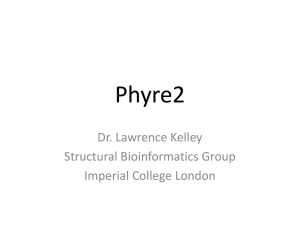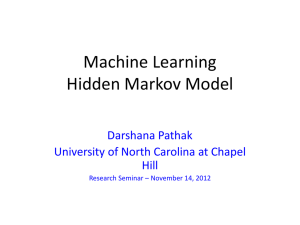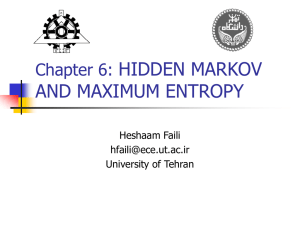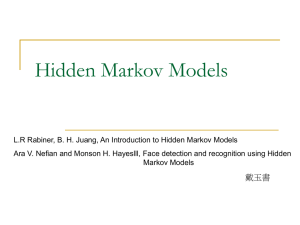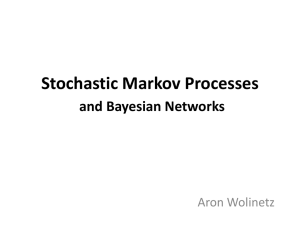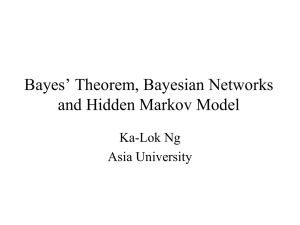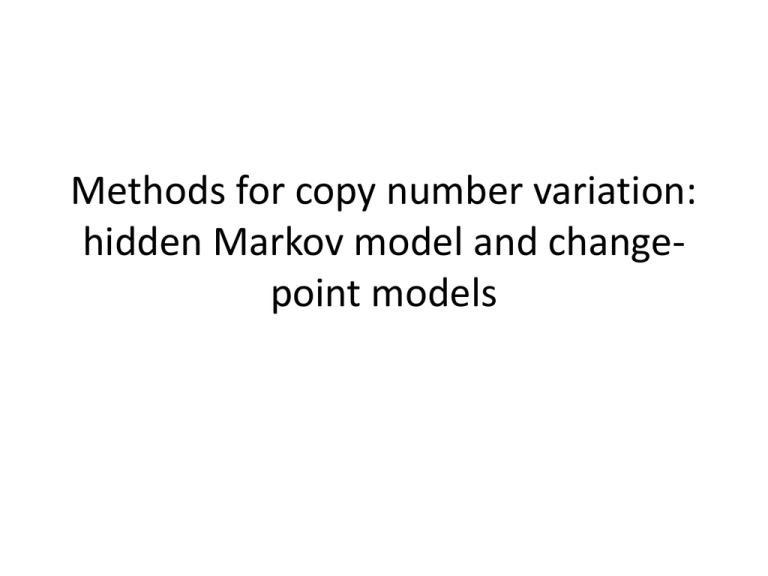
Methods for copy number variation:
hidden Markov model and changepoint models
Copy Number Variation/Alteration
Technological improvement:
Array CGH
2000-6000 probes in an array (using Bacteria Artificial
Chromosome (BAC) clones at ~100kb in size).
Low resolution
SNP array
Millions of probes in an array (using oligo probes targeted
on known SNPs at 21-60 bp in length)
High resolution
Next generation sequencing
Measurement of each base pair
Highest resolution
Given data, how to call copy number variation?
Goal: To partition probe units into sets with the same
copy number and characterize genomic segments
Two elements to estimate:
(1) Copy number change location or regions
(2) Copy number change magnitude (amplification,
deletion and fold change)
Methods
(1) Threshold-based methods (single marker classification)
(a) Direct thresholding from contrast experiments such as sex mismatched
experiment, SKY or FISH.
(b) Thresholding from K-means clustering or mixture Gaussian model.
(c) Moving average based thresholding.
(2) Hidden Markov model (HMM)
(3) Change-point model; Circular Binary Segmentation (CBS)
(4) Wavelet analysis
(5) Genetic local search
References
Methods:
• (HMM) Hidden Markov models approach to the analysis of array CGH data
(2004)
• (CBS) Circular binary segmentation for the analysis of array-based DNA copy
number data (2004)
• (a Bayesian approach to extend change-point model) A versatile statistical
analysis algorithm to detect genome copy number variation (2004)
• (Wavelet) Denoising array-based comparative genomic hybridization data using
wavelets (2005)
Review:
• Statistical issues in the analysis of DNA copy number variations (2008)
• Computational methods for the analysis of array comparative genomic
hybridization (2006)
Comparative studies:
• A comparison study: applying segmentation to array CGH data for downstream
analyses (2005)
• Comparative analysis of algorithms for identifying amplifications and deletions
in array CGH data (2005)
Gaussian mixture model
Gaussian mixture model
work well
doesn’t work
Gaussian mixture model
Change-point model
X 1, X 2 ,
, X n : log-ratio intensities of n m arkers
0: no change; positive: am plification; n egative: deletion
X1, X 2 ,
, X T ~ N ( 1 , 1 ); X T 1 ,
, X n ~ N ( 2 , 2 )
A ssum e 1 and 2 are know n ( 1 2 1);
T , 1 , 2 are unkn ow n param eters to estim ate.
C onsider "H 0 : no change point exists" vers u s
"H A : there is exactly one change point."
Change-point model
Binary segmentation procedure:
T he likelihood ratio statistic is
Z B m ax 1 i n | Z i | , w here
Zi
( S i / i ( S n S i ) / ( n i ))
Si X 1
1 / i 1 / (n i)
Xi
R eject the null hypothesis w hen Z B is lar ge.
E stim ate T as Tˆ ar g m ax 1 i n | Z i |
Change-point model
To apply to a CNV application, the hypothesis testing of
the change-point model is applied iteratively to identify
change points T1, T2,…, until the hypothesis testing is not
rejected.
What’s the problem of this change-point model approach?
If there is a small CNV segment in between two long
unchanged regions, the hypothesis testing will not be
rejected in the first evaluation.
The problem is that the change points are detected oneby-one.
=> Extension to “Circular Binary Segmentation”
Circular Binary Segmentation
Detect two change points at a time:
T he likelihood ratio statistic now becom es
Z C m ax 1 i j n | Z ij | , w here
Z ij
(( S j S i ) / ( j i ) ( S n S j S i ) / ( n j i ))
Si X 1
1 / (i j ) 1 / ( n j i )
Xi
R eject the null hypothesis w hen Z C is lar ge.
E stim ate T1 and T 2 as ( Tˆ1 , Tˆ2 ) arg m ax 1 i j n | Z ij |
Circular Binary Segmentation
Figure 1. Olshen et al., 2004
Circular Binary Segmentation
Figure 3. Olshen et al., 2004
Hidden Markov model
© Jun S. Liu
Hidden Markov model
© Jun S. Liu
Hidden Markov model
© Jun S. Liu
Hidden Markov model
© Jun S. Liu
Hidden Markov model
Hidden Markov model
Hidden Markov model
Hidden Markov model
Hidden Markov model
Hidden Markov model
Hidden Markov model
Hidden Markov model
Hidden Markov model
Hidden Markov model
Hidden Markov model
Hidden Markov model
Currently, SNP array has mostly replaced aCGH for
cheap price and very high density.
Hidden Markov Model
• Hidden Markov Model (HMM) is widely used for
sequential data analysis.
• HMM is a simple case in Bayesian Networks (BNs)
• It is a generative model: a model for randomly
generating the observed data. (compare to
discriminative model)
• It assumes large number of conditional
independencies.
• Computational complexity is low.
Graphical Representation
Hidden layer (unobserved states)
transition
emission
Observed Data
Questions
• Evaluation:
– Given the model and its parameters, what is the
probability of generating the data we observed?
(likelihood)
• Decoding:
– Given the parameters and observed data, can we
know the sequence of hidden states? (When did the
dealer use loaded dice?)
• Learning:
– If the probabilities (initial, transition, emission) are
unknown, can we estimate them from the observed
data? (Parameter estimation)
Array CGH Example (1)
• In normal tissues, each of the chromosomes
(except for X and Y) should have 2 copies.
• In cancer tissues (or other disease), the
chromosomes may suffer from events like
amplification and deletion. Thus the cancer
chromosome will more or less than 2 copies.
• Array CGH hybridize the cancer tissue and normal
tissue, and measures the copy number change
(log2 ratio).
• Copy number change happens in segments.
• Measured data is not perfect (noisy).
Array CGH Example (2)
Array CGH Example (3)
Evaluation
• Find P(X=x) given all parameters, without
knowing the probabilities.
• A naïve thinking
– P(X=x)=∑y P(X=x,Y=y)=∑y P(Y=y)P(X=x|Y=y)
– We can brute force all the possible sequences of Y
– Very expensive in computation (Not feasible)
– But we can observe that in this formula, a lot of
computations are redundant. We can combine
them to save time.
Forward Algorithm
•
•
•
•
Define: αnk=P(x1,…xn,yn=k)
Initialize: α1k=P(x1,y1=k)=πkP(x1|y1=k)
Iteration: αn+1k= P(xn+1|yn+1=k)∑i αniai,k
Finalize: P(x)=∑k αNk
Decoding
• Local decoding:
– Backward algorithm
– yn*=argmax P(yn|X=x)
• Global decoding:
– Viterbi algorithm
– y*=argmax P(y|X=x)
Backward Algorithm
•
•
•
•
•
•
Define: nk=P(xn+1,…,xN|yn=k)
Initialize: Nk=1
Iteration: nk=Σiak,iP(xn+1|yn+1=i)n+1i
Finalize: P(x)=Σkα1k1k
Posterior: P(yn=k|x)=αnknk/P(x) ∝αnknk
Decoding: yn*=argmax P(yn|x)
Viterbi Algorithm
•
•
•
•
•
•
Goal: y*=argmax P(y|X=x) ≡ find max P(y,x)
Define: γnk=max P(y1,…,yn-1,yn=k,x1,…,xn)
Initialize: γ1k=α1k
Iteration: γn+1k=p(xn+1|yn+1=k) maxi γniai,k
Finalize: max P(y,x)=max γNk
Traceback:
– In iteration, record the maximizer i for each γnk (n>1),
i.e. record δn(k)=argmaxi γniai,k
– yN*=argmax γNk
– yn*=δn+1(yn+1*)
Learning
• Parameters θ (initial, transition and emission
probabilities/parameters) are usually
unknown.
• Here total S sequences (subscript s) are
considered sharing the same θ
• x is observed, y is unobserved
• MLE: argmax L(θ;x)=argmax P(x|θ)=argmax
ΣyP(x,y|θ) ------ Intractable
• E-M algorithm (Baum-Welch algorithm)
E-M Algorithm
• E-step (expectation):
– Calculate the expectation of log-likelihood
(sufficient statistic) given the current estimate θ(t)
and observed data x
– Q(θ|θ(t))=Ey|x,θ [log L(θ;x,y)]
(t)
• M-step (maximization):
– Maximize Q(θ|θ(t)) and update the estimate of θ
– θ(t+1)=argmaxθ Q(θ|θ(t))
• Repeat E-step and M-step till convergence
Baum-Welch Algorithm
• E-step:
– ζs,n(i)=P(ys,n=i|xS, θ(t))
– ξs,n(i,j)=P(ys,n=i,ys,n+1=j|xS, θ(t)) ------ exercise
• M-step:
– Initial: πi(t+1)=Σs ζs,1(i)/S
– Transition: ai,j(t+1)=[ΣsΣn<Nsξs,n(i,j)]/[ΣsΣn<Nsζs,n(i)]
– Emission: P(xs,n|ys,n=k) depends on the distribution
type. Generally, estimate the distribution parameters
using ζ and ξ as pseudo-counts (partial/probability
counts).
• Repeat E-step and M-step till convergence
Tips
• E-M algorithm aims to find the MLE
• E-M algorithm is guaranteed to converge
• E-M algorithm is not guaranteed to converge to
the global maximum
• When programming your own HMM, be aware of
data underflow (numbers too close to zero)
– Use log transformation
– Store scale parameters in each iteration (Forward,
Backward and Viterbi)
HMM and Other Methods
Naïve Bayes/Mixture Model
HMM
Yi
Y1
Y2
Y3
Xi
X1
X2
X3
Computer Program for HMM
•
•
•
•
•
R Package “HMM”
R Package “msm”
“HMM” toolbox for Matlab
…
Make your own code
– Matlab, C, Java, …
– Do not use pure R code (too slow)



